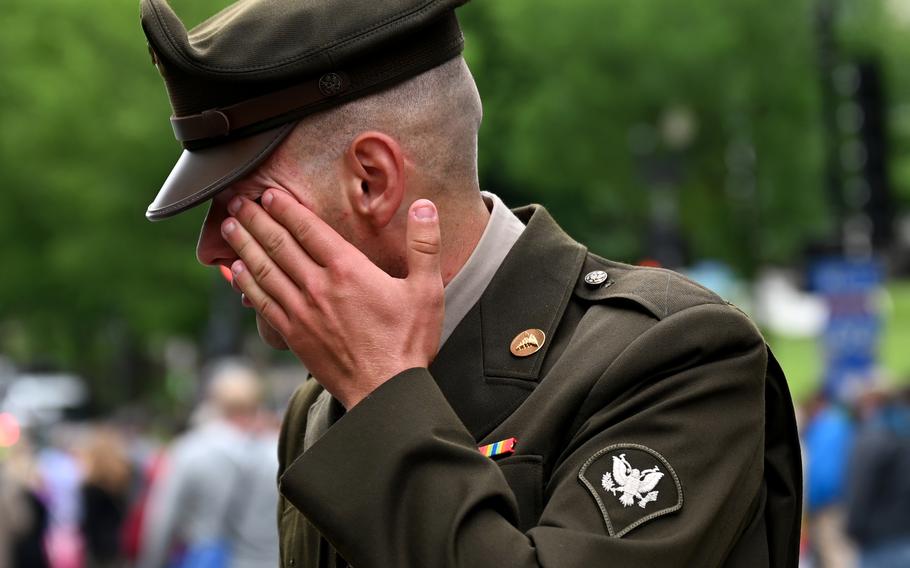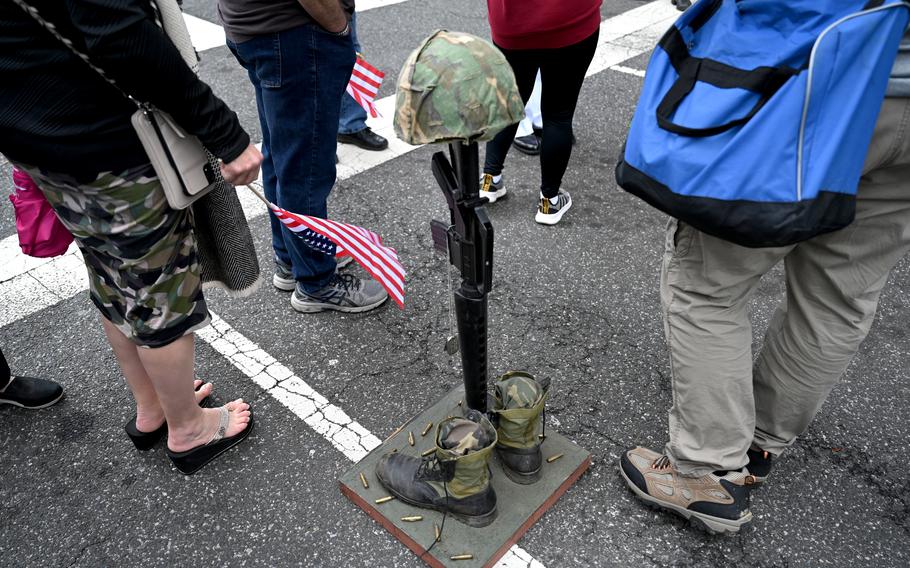
Army National Guard Spec. Joseph Wolfe of Hagerstown, Md., wipes away tears after he saluted the hundreds of motorcyclists in the Rolling to Remember demonstration in May 2021 in Washington. (Katherine Frey/The Washington Post)
Nearly 50,000 veterans and former service members received free emergency suicide prevention care in 2023 in the first year of a new Department of Veterans Affairs program, the department announced Wednesday.
VA has said that ending veteran suicide is its top clinical priority, and a White House fact sheet ahead of President Biden’s 2023 State of the Union called suicide among veterans a “public health and national security crisis.”
VA Secretary Denis McDonough said in a statement the expansion may have saved thousands of lives.
“There is nothing more important to VA than preventing veteran suicide,” McDonough said in a statement. “We want all veterans to know they can get the care they need, when they need it, no matter where they are.”
The initiative is designed to help those in “acute suicidal crisis” access emergency services at VA and non-VA facilities and saved the former service members at least $64 million in health care costs, according to VA. The policy covers 30 days of inpatient or crisis residential care, 90 days for outpatient care and related transportation costs.
The release of the data Wednesday comes amid a growing mental health crisis among former service members and across the country. While information on veteran suicides has not yet been released for 2022 or 2023, 6,392 died by suicide in 2021 — more than 17 per day — a slight increase after two years of declines. More than 71,000 veterans have died by suicide since 2010, according to the White House.
The nation saw similar trends during the first full year of the coronavirus pandemic, with a total of 40,020 deaths in 2021, an increase of 2,000 from 2020.

People gather near the tribute to the fallen after the Rolling to Remember demonstration in May 2021 in Washington. (Katherine Frey/The Washington Post)
But the roughly 18 million veterans are at higher risk for suicide than the general population, according to the American Psychological Association, as veterans’ demand and need for mental health services continues to grow. The Government Accountability Office reported in 2021 that veterans are 1.5 times more likely to die by suicide.
M. David Rudd, a psychology professor at the University of Memphis who studies suicide risk, said it’s important to understand what percentage of total mental health visits from veterans the data released Wednesday represents. If that percentage is low, he said, it shows VA may have more work to do to address veterans’ hesitation to seeking care.
“Arguably the most significant impact, in terms of psychical and emotional well-being, of Iraq and Afghanistan is the psychological consequences of those wars,” Rudd said. “We need to do much more about stigma, normalizing care and communicating the value of that care.”
VA did not have that data immediately available, according to spokesperson Gary Kunich.
Still, some experts view the 50,000 people reached as a success, even if there’s room for improvement.
“Having 50,000 veterans at high risk of suicide accessing emergency services is a big accomplishment,” said Carrie Farmer, co-director of the Rand Corporation’s Epstein Family Veterans Policy Research Institute, calling it a “great start.”
Farmer added that it’s unclear how many veterans should have accessed emergency care through the program but didn’t know they could, and that VA could always do a better job of making sure more patients and providers know who is eligible. She noted that all veterans, regardless of if they are enrolled in VA health care services — only about half are — could receive services through the program.
Homelessness among veterans also increased by 7.4% in 2023, according to VA, with more than 35,000 veterans recorded in last year’s count by the Department of Housing and Urban Development.
Earlier this month, ProPublica reported that VA hospitals and clinics appeared to systemically struggle to treat veterans struggling with mental health issues. The organization’s findings were based on a review of hundreds of facility surveys and government investigations.
For active-duty members, the suicide rate increased by 3% in 2022 from 2021, according to the Defense Department.
“The VA is doing everything it can, including expanding mental health screenings, a proven program that recruits veterans to help other veterans understand what they’re going through,” Biden said during that speech. “We’ve got to do more.”
In addition to expanding care for veterans in suicidal crisis, VA helped establish the 988 suicide hotline as a way for them to find care.
If you are a veteran in crisis, to reach responders, dial 988, then press 1. You can also text and chat the lifeline here.